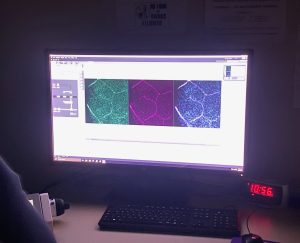I’ve been eager to get started in a lab since I stepped foot on Duke’s campus for the first time as an enrolled student. I’m thrilled to have joined the He lab, led by Dr. Sheng Yeng He, which studies plant immune responses to microbes and pathogens, especially under changing temperatures and humidity. Despite my pithy title, I’m actually not expecting any groundbreaking results in my first eight weeks as an undergraduate researcher. I expect to learn a lot, network and form relationships, have amazing experiences, fail a lot, and hopefully succeed at least some on my path to whatever results or non-results I get at the end of the summer.
I look forward to the rest of the summer with great excitement and much of that is due to how great my mentor is. I work with my lab manager, Saunia Withers, who has made me feel confident in my competency while creating a comfortable space to make mistakes and ask questions. Similarly, my PI has gone out of his way to make me feel included in the lab community! I’ve been in the lab for a few weeks; because I live in Durham, I was able to get some extra training before BSURF started and I’m very thankful for that– although I still have lots to learn!
I love the subject matter that I’m working with. On my BSURF application I mentioned how much I enjoy learning about mechanistic processes; signal transduction pathways and the interactions between biomolecules that make us function the way we do. In my first week, my lab manager, a postdoc who kindly helped us, and I initiated a calcium response from Arabidopsis thaliana (the model organism my lab works with) by using a flagellum protein from a pathogen, then imaging the response using a confocal– a protocol that our postdoc adapted from this paper.
Since then, I have been reading up to try to decipher what we know about the role of calcium in the plant immune system. Although the actual process of comprehending these complex articles is arduous, I’ve fallen in love with the feeling of satisfaction I get when everything finally clicks. And luckily, this line of inquiry aligns perfectly with my interests. I still have more findings to comb through, and I don’t think there’s a definite answer about the role of calcium out there yet (which makes it a perfect thing to keep studying!). But what I have found has helped me build a mental picture of the mechanisms calcium is a part of in the plant immune response, specifically in the opening and closing of stomata, which are tiny pores in plants through which they “breathe,” and which are also usually closed as a result of the immune system activating.
Ahead of me, I have plant care and harvesting, batches of genotyping, and more calcium imaging. As Dr. Grunwald quipped, lots of moving colorless liquids from one tube to another. And a lot of learning how to use cool machines! I couldn’t be more excited!


Yay! I also love the feeling when everything clicks and makes sense in my head. So even though we all have to go through the inevitable failed experiments or confusing results, its an exciting thing to puzzle everything together along the way!